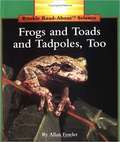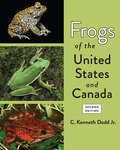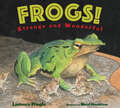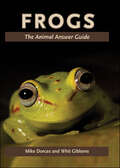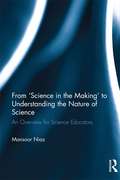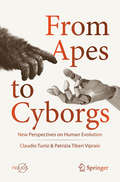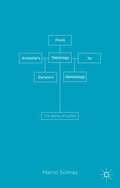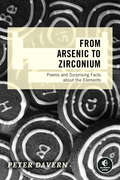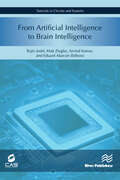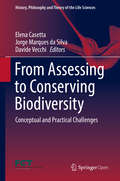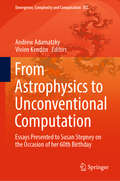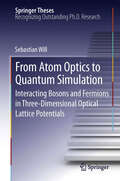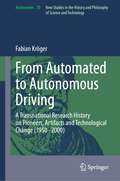- Table View
- List View
Frogs
by David BadgerFrom the Book Jacket: Frogs have long played a role in tales of legend and lore-symbolizing fertility, omens, ... and more. Frogs is an introduction to the world's most fascinating frogs and toads, including detailed frog characteristics, their life cycles, musical repertoires, and conservation issues. David Badger's interesting text and John Netherton's brilliant, up-close photographs bring these fascinating creatures to life as you've never before seen them. Discover the world's animals in the World Life Library from Voyageur Press. This highly acclaimed series brings you the latest research from leading naturalists, along with stunning color photographs of your favorite animals.
Frogs
by Emily GreenFrogs are powerful jumpers. They have been known to leap distances over 30 feet! Young learners will discover the physical characteristics of frogs, where they live, and what they eat to get the energy to leap.
Frogs (Readers)
by Elizabeth CarneyWHAT WAS THAT? That&’s the roaring burp of a bullfrog! SEE THAT? That&’s the slick, shiny skin of colorful little rainforest frogs! Alive with froggy facts, this book has the coolest photos to bring kids deep into the swampy world of our amphibian amigos.National Geographic supports K-12 educators with ELA Common Core Resources.Visit www.natgeoed.org/commoncore for more information.
Frogs and Toads and Tadpoles, Too (Rookie Read-About Science: Animals)
by Allan FowlerThis series meets National Curriculum Standards for: Science: Earth and Space Science, Life Science. Social Studies: Global Connections, Production, Distribution, & Consumption
Frogs into Princes: Neuro Linguistic Programming
by Richard Bandler John Grinder John O. StevensIn one sense nothing that NLP can accomplish is new. There have always been "spontaneous remissions," "miracle cures," and other sudden and puzzling changes in people's behavior, and there have always been people who somehow learned to use their abilities in exceptional ways. What is new in NLP is the ability to systematically analyze those exceptional people and experiences in such a way that they can become widely available to others.
Frogs of the United States and Canada
by C. Kenneth Dodd Jr.The most thorough, updated guide to frogs and toads in the United States and Canada available.A stunning diversity of frog species can be found from coastal swamps to lofty mountain peaks, and from the Florida Keys to the Arctic Ocean. They live in subtropical lowlands, grassland prairies, deserts, and alpine-tundra habitats. Some species have restricted habitat requirements, whereas others occur contiguously from the arid plains or humid southeastern forests to the high tundra. In this new edition of Frogs of the United States and Canada, C. Kenneth Dodd Jr. tours the reader through the marvelous world of North American frogs. Covering 114 native and introduced species from all US states and Canadian provinces, this comprehensive reference on the biology, behavior, and conservation of the Order Anura includes detailed and updated information on• past and present distribution • life history and demography • reproduction and diet• landscape ecology and evolution• diseases, parasites, and threats from toxic substances• conservation and management Hundreds of occurrence maps, line drawings, and new color photographs of frogs and their habitats enhance the text. The most thorough treatment of the life histories, distribution, and status of North American frogs ever produced, Frogs of the United States and Canada has been the go-to reference for naturalists, scientists, and resource managers in their efforts to understand and conserve frogs, their habitats, and biodiversity for over a decade. Based on a meticulously updated examination of more than 8,000 references current through 2021, this second edition ensures Dodd's master work will remain an unparalleled resource for years to come.
Frogs!: Strange and Wonderful (Strange and Wonderful)
by Laurence PringleAre kids going to love this book? Is a frog waterproof? The latest title in the popular Strange and Wonderful series delivers the awe-inspiring variety of frogs, the world's hoppiest amphibians. Did you know that the Goliath frog is more than a foot long? Or that the tiny gold frog could sit on a dime? Some frogs have camouflage. Others wear bold colors warning their enemies that they are poisonous. Some frogs leap, others hop, one is a runner, and a few glide from tree to tree with their big, webbed hands and feet! Surprising facts and beautiful, realistic nature illustrations come together in this celebration of one of nature's most fascinating marvels.
Frogs: The Animal Answer Guide (The Animal Answer Guides: Q&A for the Curious Naturalist)
by Mike Dorcas Whit GibbonsFrogs are amazingly diverse—ranging from the massive goliath frog, which weighs several pounds, to the recently discovered gold frog, which measures a mere three-eighths of an inch when fully grown—and have inhabited the earth for more than 200 million years. Today, however, these amphibians face more challenges than any other vertebrate group. In this fun and informative book, herpetologists Mike Dorcas and Whit Gibbons answer common and not-so-common questions people may have about these fascinating animals.Dorcas and Gibbons discuss how frogs evolved, which species currently exist in the world, and why some have recently gone extinct. They reveal what frogs eat and what eats them, their role in cultures across the globe, why many populations are declining and what we can do to reverse this dangerous trend, why there are deformed frogs, and much more. They answer expected questions such as "What is the difference between a frog and a toad?" and "Why do some people lick toads?" and unexpected ones such as "Why do some frogs lay their eggs in the leaves of trees?" and "Do frogs feel pain?" The authors’ easy-to-understand yet thorough explanations provide insight into the amazing biology of this amphibian group. In addressing conservation questions, Dorcas and Gibbons highlight the frightening implications of the current worldwide amphibian crisis, which many scientists predict will bring extinction rates experienced by frog species to levels not seen in any vertebrate animal group in millions of years.Packed with facts and featuring two color galleries and 70 black-and-white photographs, Frogs: The Animal Answer Guide is sure to address the questions on the minds of curious naturalists.
From 'Science in the Making' to Understanding the Nature of Science: An Overview for Science Educators
by Mansoor NiazThe Nature of Science is highly topical among science teacher educators and researchers. Increasingly, it is a mandated topic in state curriculum documents. This book draws together recent research on Nature of Science studies within a historical and philosophical framework suitable for students and teacher educators. Traditional science curricula and textbooks present science as a finished product. Taking a different approach, this book provides a glimpse of “science in the making” — scientific practice imbued with arguments, controversies, and competition among rival theories and explanations. Teaching about “science in the making” is a rich source of motivating students to engage creatively with the science curriculum.Readers are introduced to “science in the making” through discussion and analysis of a wide range of historical episodes from the early 19th century to early 21st century. Recent cutting-edge research is presented to provide insight into the dynamics of scientific progress. More than 90 studies from major science education journals, related to nature of science are reviewed. A theoretical framework, field tested with in-service science teachers, is developed for moving from ‘science in the making’ to understanding the Nature of Science.
From A to Bee: My First Year as a Beginner Beekeeper
by James DearsleyJames Dearsley’s wife thought he had lost his mind when he announced his intention to become a beekeeper. Like many interested in self-sufficiency, he loved gardening and growing vegetables and he wanted to teach his little boy where honey came from, so he set himself a goal: to get, in a year’s time, just one jar of honey.
From A to Bee: My First Year as a Beginner Beekeeper
by James DearsleyJames Dearsley’s wife thought he had lost his mind when he announced his intention to become a beekeeper. Like many interested in self-sufficiency, he loved gardening and growing vegetables and he wanted to teach his little boy where honey came from, so he set himself a goal: to get, in a year’s time, just one jar of honey.
From Alchemy to Chemistry (Dover Science Books)
by John ReadWritten for the layman, this accessible history takes a broad, humanistic perspective, eschewing chemical equations and formulae. Instead it concentrates on the great figures of chemistry and the ideas that revolutionized the science, from earliest history to the modern era.Much of the book is devoted to alchemy and such topics as the philosopher's stone, alchemical crypticism and symbolism, pseudo-alchemists, Paracelsus, and the "swan song" of alchemy as the scientific revolution took hold. In the final chapters, the author takes up the development of modern chemistry, including atomic theory, the nature of the elements, the beginning of organic chemistry, and more. Broad in scope, erudite yet readable, this rich and absorbing narrative will appeal to anyone interested in the long and colorful history of chemical science. Glossary. 50 illustrations.
From Animals to Animats 14
by Elio Tuci Alexandros Giagkos Myra Wilson John HallamThis book constitutes the proceedings of the 14th International Conference on Simulation of Adaptive Behavior, SAB 2016, held in Aberystwyth, UK, in August 2016. The 31 papers presented in this volume were carefully reviewed and selected from 45 submissions. They cover the main areas in animat research, including the animat approach and methodology, perception and motor control, learning and adaptation, evolution, and collective and social behavior.
From Apes to Cyborgs: New Perspectives on Human Evolution (Springer Praxis Books)
by Claudio Tuniz Patrizia Tiberi VipraioThis book offers fascinating insights into the lives of our ancestors and investigates the dynamic processes that led to the establishment of complex human societies. It provides a holistic view of human history and social evolution by drawing on the latest evidence from a wide range of disciplines and proposes new hypotheses on the origins of human behaviour. After exploration of the encounters of Homo sapiens with other human species, diverse aspects of life in emerging societies are examined, including clothing, work, leisure, learning, diet, disease, and the role of women. Attention is drawn to the key role of self-domestication – the process of reducing natural aggression and increasing playfulness – in enabling survival. Another focus is Homo oeconomicus. The significance of symbolic thought for the emergence of surpluses in goods and services is highlighted, with analysis of how this led to private accumulation of wealth and development of the first hierarchical societies. Finally, the discussion turns to humans of the future and the potential risks posed by artificial intelligence. The aim is to unveil the deep roots of our social behaviour and how it is going to intertwine with the development of digital technologies and social networks.
From Arabia to the Pacific: How Our Species Colonised Asia
by Robin DennellDrawing upon invasion biology and the latest archaeological, skeletal and environment evidence, From Arabia to the Pacific documents the migration of humans into Asia, and explains why we were so successful as a colonising species. The colonisation of Asia by our species was one of the most momentous events in human evolution. Starting around or before 100,000 years ago, humans began to disperse out of Africa and into the Arabian Peninsula, and then across southern Asia through India, Southeast Asia and south China. They learnt to build boats and sail to the islands of Southeast Asia, from which they reached Australia by 50,000 years ago. Around that time, humans also dispersed from the Levant through Iran, Central Asia, southern Siberia, Mongolia, the Tibetan Plateau, north China and the Japanese islands, and they also colonised Siberia as far north as the Arctic Ocean. By 30,000 years ago, humans had colonised the whole of Asia from Arabia to the Pacific, and from the Arctic to the Indian Ocean as well as the European Peninsula. In doing so, we replaced all other types of humans such as Neandertals and ended five million years of human diversity. Using interdisciplinary source material, From Arabia to the Pacific charts this process and draws conclusions as to the factors which made it possible. It will be invaluable to scholars of prehistory, and archaeologists and anthropologists interested in how the human species moved out of Africa and spread throughout Asia.
From Aristotle’s Teleology to Darwin’s Genealogy
by Marco SolinasStarting with Aristotle and moving on to Darwin, Marco Solinas outlines the basic steps from the birth, establishment and later rebirth of the traditional view of living beings, and its overturning by evolutionary revolution. The classic framework devised by Aristotle was still dominant in the 17th Century world of Galileo, Harvey and Ray, and remained hegemonic until the time of Lamarck and Cuvier in the 19th Century. Darwin's breakthrough thus takes on the dimensions of an abandonment ofthe traditional finalistic theory. It was a transition exemplified in the morphological analysis of useless parts, such as the sightless eyes of moles, already discussed by Aristotle, which Darwin used as a crowbar to unhinge the systematic recourse to final causes. With many excerpts, a chronological sequence and an analytical approach, this book follows the course of the two conceptions that have shaped the destiny of living beings in western culture.
From Arsenic to Zirconium: Poems and Surprising Facts about the Elements
by Peter Davern93 short poems that teach about the elements of the periodic table. Indulge your love of the periodic table with this collection of poems and fun facts about the chemical elements that make up our world. From arsenic to zirconium, this book describes the characteristics, history, and quirks of each element. The poems are a launching point for a guided tour of the elements filled with fascinating scientific trivia. For instance: • Antimony, used to treat constipation in the Middle Ages, may have killed Mozart. • There's arsenic in your prawns! (But don't worry, it won't harm you.) • Erbium is used to "dope" optical fiber amplifiers that make your YouTube videos download faster. • Iridium was key to the meteor theory of why dinosaurs went extinct. • You'll find potassium in both bananas and gunpowder. • Sulfur plays a role in whether your hair is curly or straight.Expand your library of scientific literature with this playful and poetic romp through the periodic table.
From Artificial Intelligence to Brain Intelligence: AI Compute Symposium 218
by Arvind Kumar Eduard Alarcon Rajiv Joshi Matthew ZieglerResearch in Artificial Intelligence (AI) is not new, it has been around since 1950’s. AI resurfaced at that time while Moore’s law was on an aggressive path of scaling, with the transformation of NMOS and later bipolar technology to CMOS for high performance, low power as well as low cost applications.Several breakthroughs in the electronics industry helped to push Moore’s law in chip miniaturization along with increased computing power (parallel and distributed processing) and memory bandwidth. Once this paradigm shift occurred it naturally opened doors for AI as it required big data manipulations, and thus AI could thrive again. AI has already shown success in industries such as finance, marketing, health care, transportation, gaming, education and the defence and space, to name but a few.The human brain amazingly has a memory in the order of millions of digital bits, however it cannot compete with machines for data crunching and speed. Thus tomorrow’s world will be a World of Wonders of Artificial Intelligence (WOW- AI), to compensate the computational limitations of human beings. In short, AI research and applications will continue to grow with the development of software, algorithms and hardware accelerators.To continue the development of AI, an advanced AI Compute Symposium was launched with the sponsorship of IBM, IEEE CAS and EDS, from which this book came. Overall, the book covers two broad topics: general AI advances, and applications to neuromorphic computing.
From Assessing to Conserving Biodiversity: Conceptual and Practical Challenges (History, Philosophy and Theory of the Life Sciences #24)
by Elena Casetta Jorge Marques da Silva Davide VecchiThis open access book features essays written by philosophers, biologists, ecologists and conservation scientists facing the current biodiversity crisis. Despite increasing communication, accelerating policy and management responses, and notwithstanding improving ecosystem assessment and endangered species knowledge, conserving biodiversity continues to be more a concern than an accomplished task. Why is it so?The overexploitation of natural resources by our species is a frequently recognised factor, while the short-term economic interests of governments and stakeholders typically clash with the burdens that implementing conservation actions imply. But this is not the whole story. This book develops a different perspective on the problem by exploring the conceptual challenges and practical defiance posed by conserving biodiversity, namely: on the one hand, the difficulties in defining what biodiversity is and characterizing that “thing” to which the word ‘biodiversity’ refers to; on the other hand, the reasons why assessing biodiversity and putting in place effective conservation actions is arduous.
From Astrophysics to Unconventional Computation: Essays Presented to Susan Stepney on the Occasion of her 60th Birthday (Emergence, Complexity and Computation #35)
by Andrew Adamatzky Vivien KendonThis Festschrift is a tribute to Susan Stepney’s ideas and achievements in the areas of computer science, formal specifications and proofs, complex systems, unconventional computing, artificial chemistry, and artificial life. All chapters were written by internationally recognised leaders in computer science, physics, mathematics, and engineering. The book shares fascinating ideas, algorithms and implementations related to the formal specification of programming languages and applications, behavioural inheritance, modelling and analysis of complex systems, parallel computing and non-universality, growing cities, artificial life, evolving artificial neural networks, and unconventional computing. Accordingly, it offers an insightful and enjoyable work for readers from all walks of life, from undergraduate students to university professors, from mathematicians, computers scientists and engineers to physicists, chemists and biologists.
From Atom Optics to Quantum Simulation
by Sebastian WillThis thesis explores ultracold quantum gases of bosonic and fermionic atoms in optical lattices. The highly controllable experimental setting discussed in this work, has opened the door to new insights into static and dynamical properties of ultracold quantum matter. One of the highlights reported here is the development and application of a novel time-resolved spectroscopy technique for quantum many-body systems. By following the dynamical evolution of a many-body system after a quantum quench, the author shows how the important energy scales of the underlying Hamiltonian can be measured with high precision. This achievement, its application, and many other exciting results make this thesis of interest to a broad audience ranging from quantum optics to condensed matter physics. A lucid style of writing accompanied by a series of excellent figures make the work accessible to readers outside the rapidly growing research field of ultracold atoms.
From Atoms to Galaxies: A Conceptual Physics Approach to Scientific Awareness
by Sadri HassaniCollege students in the United States are becoming increasingly incapable of differentiating between proven facts delivered by scientific inquiry and the speculations of pseudoscience. In an effort to help stem this disturbing trend, From Atoms to Galaxies: A Conceptual Physics Approach to Scientific Awareness teaches heightened scientific acuity a
From Automated to Autonomous Driving: A Transnational Research History on Pioneers, Artifacts and Technological Change (1950-2000) (Archimedes #70)
by Fabian KrögerThis book presents the most important milestones of the research on automated and autonomous driving in the United States, Japan and Europe throughout five decades (1950-2000). Drawing on sources from the automotive industry, electrical engineering, the robotics and AI-domain and military institutions, it retraces the transition from the guidance-cable approach to vehicle-based sensor and vision systems. Giving a detailed overview of the technical concepts, artefacts, research vehicles and robots, the book presents the transnational engineering efforts that started long before Silicon Valley entered the field. In addition, the book also uniquely details the role of the military in the domain of vehicle automation. This all ensures the book is of great interest to historians of technology, practitioners in engineering disciplines, scholars working in mobility studies, journalists, and political decision makers.
From Axons to Identity: Neurological Explorations of the Nature of the Self (Norton Series on Interpersonal Neurobiology)
by Todd E. FeinbergA leading neuroscientist offers an intriguing scientific journey to understanding the neurobiology of the self. What can dementia, delusions, and other neurological disorders teach us about how the brain creates personal identity and a unified sense of self? Here, a leading neurobiologist offers an intriguing scientific approach to understanding the neurobiology of the self. Drawing on both the latest neuroscientific research, as well as the author's decades of experience with neurological patients, From Axons to Identity examines the link between brain and identity in fascinating new ways. Dr. Feinberg presents case studies of individuals with brain pathologies and unusual psychiatric syndromes that cause them to deny parts of their bodies or believe in the presence of mysterious imposters or imaginary friends, and then presents a groundbreaking new theory of these conditions that relates them to the normal course of psychological development. By examining what goes wrong in individuals with these conditions, Dr. Feinberg presents an engaging new theory with far-reaching implications for the link between brain and identity. From Axons to Identity proposes a new view of the processes of the brain and the self that is unique and revelatory.



